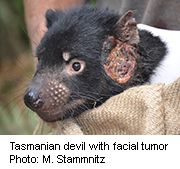- Navigating Your Midlife Crisis: Embracing New Possibilities
- City Raccoons Showing Signs of Domestication
- Mapping the Exposome: Science Broadens Focus to Environmental Disease Triggers
- One Week Less on Social Media Linked to Better Mental Health
- Your Brain Changes in Stages as You Age, Study Finds
- Some Suicide Victims Show No Typical Warning Signs, Study Finds
- ByHeart Formula Faces Lawsuits After Babies Sickened With Botulism
- Switch to Vegan Diet Could Cut Your Greenhouse Gas Emissions in Half
- Regular Bedtime Does Wonders for Blood Pressure
- Dining Alone Could Mean Worse Nutrition for Seniors
Human Cancer Meds Might Help Save Tasmanian Devils

Drugs that fight cancer in people could help treat cancers that put Tasmanian devils at risk of extinction, researchers report.
They found that two transmissible cancers — devil facial tumor 1 (DFT1) and devil facial tumor 2 (DFT2) — are closely related and that molecules called receptor tyrosine kinases (RTKs) play an important role in both.
Some human cancer drugs target RTKs. In lab tests, these drugs also stopped growth of the two cancers that afflict Tasmanian devils. It may be possible to use them to treat the devil facial tumor cancers, according to researchers at the University of Cambridge in England.
“Altogether, our findings suggest that transmissible cancers may arise naturally in Tasmanian devils. We found no DNA-level evidence of these cancers being caused by external factors or infectious agents such as viruses,” first author Maximilian Stammnitz said in a university news release. He is a doctoral student in the Transmissible Cancer Group.
DFT1 is known to spread by biting, and that’s probably also true for DFT2, according to the researchers. Both cancers go undetected by the devil’s immune system.
Tasmanian devils are the world’s largest carnivorous marsupials, found wild only on the island of Tasmania, Australia. The DFT1 cancer was first noted in northeast Tasmania in 1996 and has since spread throughout the island, causing significant declines in devil numbers. DFT2 was discovered in 2014 and appears to be limited to a peninsula in Tasmania’s southeast.
“The discovery of a second transmissible cancer in Tasmanian devils was a huge surprise,” said research team leader Elizabeth Murchison. She is a group leader in the Department of Veterinary Medicine.
“Other than these two cancers, we know of only one other naturally occurring transmissible cancer in mammals — the canine transmissible venereal tumor in dogs, which first emerged several thousand years ago,” she explained.
Murchison said the story of Tasmanian devils being killed off by disease in recent years has been troubling.
“This study gives us optimism that anti-cancer drugs that are already in use in humans may offer a chance to assist with conservation efforts for this iconic animal,” she said.
The study was published April 9 in the journal Cancer Cell.
More information
The Tasmania Parks and Wildlife Service has more on the Tasmanian devil.
Source: HealthDay
Copyright © 2025 HealthDay. All rights reserved.










